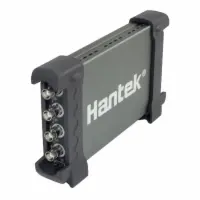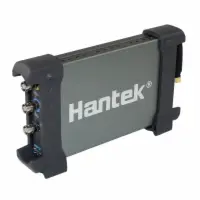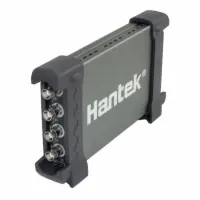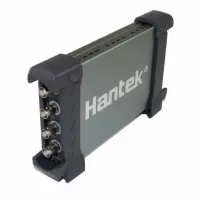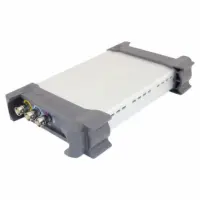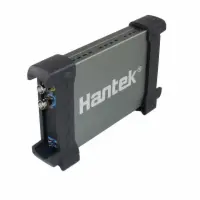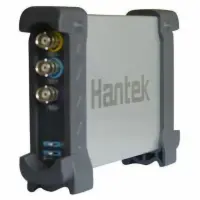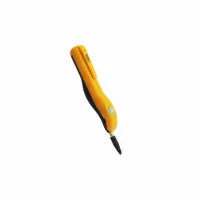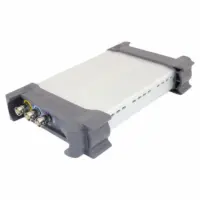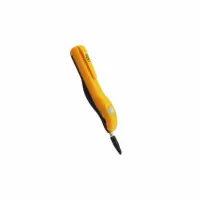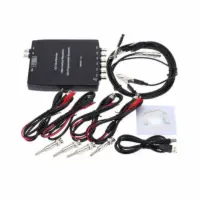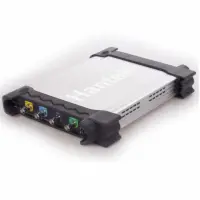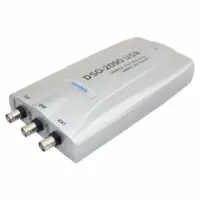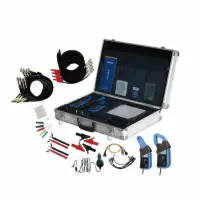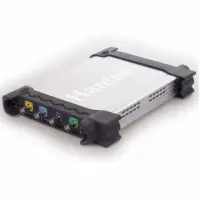PC-Based USB Oscilloscopes
A USB oscilloscope, also known as a PC oscilloscope, is a digital oscilloscope that connects via a USB to an external computer, which is where all of the measurements are displayed and managed.
These portable, budget-friendly oscilloscopes forgo the traditional built-in screen and button interface. Instead, a computer provides the display and interface, saving benchtop space and making it easier to transfer and store measurements. In general, PC-based oscilloscopes are more cost-effective when compared to benchtop or handheld oscilloscopes with similar specifications.
Most PC-based USB oscilloscopes resemble a small portable computer hard drive. Multifunctional USB scopes may come with a logic analyzer, function generator, and other testing capabilities in addition to an oscilloscope.
Automotive oscilloscopes are often PC-based as well and include automotive diagnostic tools and tests that go beyond typical oscilloscopes.
Some PC-based oscilloscopes come in a pen form, incorporating an oscilloscope probe into the base design. These pocket oscilloscope pens still require a USB connection to a PC or laptop to operate.
A newer kind of PC-based oscilloscope, sometimes called an iPhone oscilloscope or smartphone oscilloscope, has the capability to wirelessly connect to iPhones, iPads, or Android products in addition to PCs.
USB oscilloscopes often take the form and size of a portable computer hard drive. True to its name, the scope will have a USB port that allows you to connect the oscilloscope to the PC. The USB oscilloscope will have other inputs for your test leads and probes. If you have a pen oscilloscope, the scope itself is the oscilloscope probe, which you will still connect via USB to a PC.
Once the USB scope is properly connected to your PC or laptop, the PC’s keyboard and screen become the oscilloscope’s interface and display.
You may be required to download software or have certain computer settings in order for the oscilloscope to operate. Once this software is installed, you can start taking and viewing oscilloscope measurements.
Budget-friendly: USB oscilloscopes are incredibly cost-effective, which is why they are especially popular among hobbyists, makers, and educational institutions. Some PC oscilloscopes add an arbitrary waveform generator and logic analysis, providing even more value.
Portable: PC-based oscilloscopes are easy to store and transport. They can be used wherever a compatible computer is present, whether that’s at a lab or in the field.
Space-saving: USB oscilloscopes take up less space than benchtop units—pen-type oscilloscopes can even fit in your pocket!
Saves Data: Most USB oscilloscopes and the associated software allow you to transfer and store oscilloscope measurements.
User-friendly: PC-based oscilloscopes are easy to set up and use.
Flexible Screen Size: The PC you use determines the screen size, so your display is likely to be much larger than standard handheld oscilloscopes and even benchtop units.
Requires computer: USB oscilloscopes need a computer to operate, which can incur additional costs if you don’t already own a PC.
Possible Compatibility Issues: PC-based oscilloscopes may have specific requirements for the PC or laptop you plan to use it with. Always check for compatibility before you purchase a USB scope.

